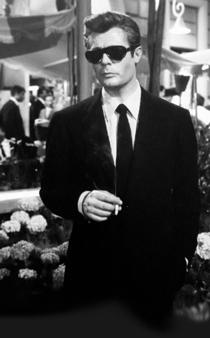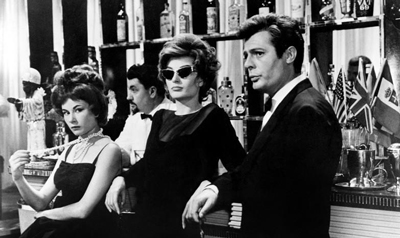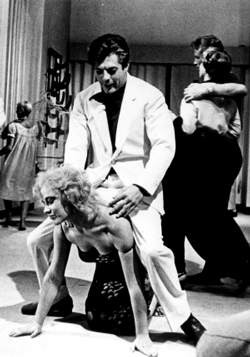
 |
|
|
|
After several good but not great DVD releases of the past fifteen years, Federico Fellini's La dolce vita finally comes to Region A Blu-ray from Criterion, who give it the treatment it deserves. The still-lauded Italian masterpiece marks the moment when Fellini's films began being more about his own state of mind, than any particular story. As it both celebrates and questions the then-idealized vision of the Roman high life, and then goes further to ponder an existential restlessness amid the glamour and materialism. Perhaps Michelangelo Antonioni holds the crown for inaccessibility, but mention the words 'Italian art film' and it's Fellini's work that first comes to mind. 
An almost instant brand name for luxury and decadence, La dolce vita arrived as the Italian film industry was at its peak. In the early '60s Rome was the cinema center of Europe. La dolce vita shows the director expanding his canvas to covers the 'happening place' of a Roman scene that orbits around celebrities, the media, nightlife and sensation. At the center of it all is Marcello Mastroianni, whose character 'Marcello' both embodies and experiences the decline of traditional values in this glossy, shallow new world. Society and culture newspaper reporter Marcello Rubini has one girlfriend with marital ambitions (Yvonne Furneaux) and another one obsessed with her aristocratic friends (Anouk Aimée). He zips around Rome overseeing trashy photo layout stories on various groups of intellectuals and hedonists. Swank nightclubs are his natural element, and every night is a party that lasts until dawn. Marcello claims that he's searching for something with more meaning, but there's always another party or another movie star to cover, like the alluring Silvia (Anita Ekberg).La dolce vita is a movie of uncommon balance for Fellini. He considered Otto e mezzo his most personal show but this one seems better organized, with at one foot at least in reality - it isn't dominated by extended dream sequences. Although it creates dreamy set piece scenes like the timeless encounter at the Trevi fountain, Vita avoids overt abstractions. Marcello would like to continue floating through life as if it were a stream of pleasant sensations� but even he can sense the absence of something. Marcello is too absorbed by the fast life to experience the crisis of faith that the film suggests he wants and needs. He witnesses fraudulent distortions of Catholicism, from superstar Sylvia's PR invasion of the Vatican (wearing a designer dress that looks like a priest's outfit) to a phony miracle that becomes a media circus. Marcello talks about changing his life and doing meaningful writing but there are just too many distractions. He's the unofficial master of ceremonies for the party crowd, as well as the de facto commander of a small army of mosquito-like scandal photographers. 1 He's the king of the Via Veneto, the official boulevard watering hole for the nocturnal fast crowd. Interesting women want to sleep with him, while he feels trapped by the demands of his live-in girlfriend. He talks about not wanting to be stifled by marriage, even though it's obvious that he's much too self-centered to give up a single night of sexual adventure. With looks that can turn the head of a movie star like Sylvia, Marcello sees no need to grow up. 
The movie insists otherwise, and La dolce vita is a parade of situations that show Marcello as an intelligent man all too aware that he's been seduced by 'the sweet life.' His associates are jaded intellectuals, obnoxious celebrities, the decadent rich and the sycophants who surround them. Marcello does engage in meaningful dialogues with two role models. He seeks advice from Steiner (Alain Cuny), a successful intellectual and an admirable family man. Marcello also has a surprise visit from his estranged father (Annibale Ninchi), a lively old fellow who suddenly seems to be an okay guy. 2 When this art movie goes symbolic, it doesn't go soft. Yes, the 'flying Christ' statue held aloft by a helicopter as it zooms across ancient ruins is a daring satiric gag. It provides the perfect pick-up introduction for Marcello to use on some bikini'd girls on a swanky rooftop. The giant figure reminds us of the stolen statue in I Vitelloni, but it's also the mirror image of the film's final symbol, the monster fish dredged out of the sea in the final scene. Is it the 'rude beast,' the Anti-Christ? Or is it a comment on a life of pleasure that is losing contact with traditional morality? Marcello will never voluntarily abandon this lifestyle, and the monster is a representation of his dead values. 
At least, that's the interpretation that appeals to me personally. European art movies encourage this kind of thinking. The religious statue is old and venerated but in the process of being trashed by vulgar modernism. It's made of inert stone but its spirit is alive. The sea monster is a dead creature that reeks of corruption. In his sneakily moralizing way, Fellini leads his debauched partygoers out through a grove of trees to witness this nasty symbol of their depravity. Fellini's brilliance is to not spell this out in so many words. The sea monster can be just a rotting fish. We feel its significance, as opposed to reading it. And it sets up Marcello's final encounter with Paola (Valeria Ciangottini), the angelic girl from the seaside café, the one with the bright and honest smile. Marcello can't hear her; he needs to rejoin his demanding friends. At the fadeout, Paola briefly looks right at the camera, and we get the same emotional jolt we felt when Fellini's Cabiria did the same thing. La dolce vita makes intimate human contact with us in a way that many of Fellini's later pictures don't. As is usual with a movie that sums up and transcends its own moment in time, La dolce vita has its unrepeatable qualities. Marcello Mastroianni's stroll into the fountain with Anita Ekberg is the pinnacle of voluptuous glamour, a fashion-show contrasting modern and ancient Italian style. Anouk Aimée also nails a timeless look, a natural cool that Marcello finds irresistible. This picture likely sold a lot of Triumph automobiles and Roman vacations. 
La dolce vita was made before Fellini settled into his later "all grotesques, all weirdos" casting philosophy. There are plenty of curious types here but not the parade of circus clowns that send Giulietta degli spiriti over the edge. Fellini instead stacks the show to the rafters with some of the most beautiful, or photographically seductive, women of the time. Aimee and Ekberg are fantastic in themselves, but also notable is the sharply arresting Yvonne Furneaux (Repulsion, The Mummy) as the cloying girlfriend Emma. Laura Betti, Nico and Nadia Gray are various night birds, and Magali Noël (Rififi) is a nightclub dancer who takes a fancy to Marcello's father. Screen Tarzan Lex Barker makes a notable appearance, as an arrogant American actor who drives a Corvette and is known for playing Tarzan. Criterion's Blu-ray of La dolce vita is given the Collection's expected high polish. The image is of course better than the older DVDs. The wide frame makes B&W look exceedingly luxurious, with the pre-dawn exteriors often capturing the spectacle of women in lavish gowns caught long after the party has ended. See two or three of the best Italian pictures of this time, and you'll believe that Italian cameramen simply delivered better images than their Hollywood counterparts. The extras begin with additional interviews with Fellini and Mastroianni from the 1960s. A new interview with Lina Wertmüller gives us her thoughts on the filming; she served as an assistant director. Other equally illuminating interview featurettes add the input of critic-journalist Antonello Sarno, and cultural-historical expert David Forgacs.
Criterion still sets the mark for authoritative disc extras. For the last few years they've also contracted Visual Essays by selected critics. Most of these are highly informative and enlightening. I'm not a fan of the "::kogonada" essay for this title. It argues only one point -- the nature of camera angles that shift from the objective to the subjective. Ethereal music and fancy editing treat Fellini's movie with awe, as if it were a holy text. When the smiling Paola on the beach looks directly at us, ::kogonada pegs the 'eye contact moment'
On a scale of Excellent, Good, Fair, and Poor,
La dolce vita Blu-ray Footnotes:
1. One of the photographers is named "Paparazzo", which is where the term paparazzi comes from.
2. One of Marcello's honored intellectual teachers and role models commits suicide, which understandably casts a cloud over Mastroianni's outlook -- it would seem that the 'great man' concluded that life was not worth living. Woody Allen seems to have adapted a situation like this for his thoughtful Crimes and Misdemeanors.

The version of this review on the Savant main site has additional images, footnotes and credits information, and may be updated and annotated with reader input and graphics.
Review Staff | About DVD Talk | Newsletter Subscribe | Join DVD Talk Forum |
| ||||||||||||||||||